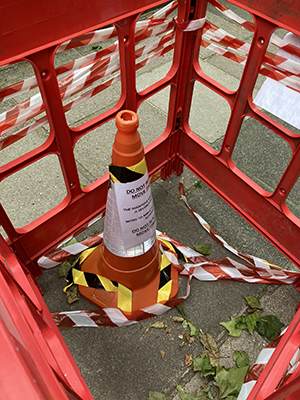Of all objects, it is surely hard to think of a more egalitarian one than the humble traffic cone.
Utilitarian in function; identical in design; ubiquitous in society. The world of the traffic cone is surely an equal one?
Existing in sprawling communities of ribbon development across most major road systems; indistinguishable one from another; no opportunity for neighbour-envy or keeping up with the Coneses. The ideal socialist society could have been based on the realm of the traffic cone.
But, is all quite as free and equal as it might appear on the surface? Or are some traffic cones more equal than others?
Walking in Bloomsbury recently, I encountered one traffic cone, which seemed to have been earmarked for special treatment. Isolated from his peers; restrained by hi-viz masking tape; kettled on all sides by four confining plastic barriers, here was a traffic cone, which appeared to be the subject of persecution and banished to solitary confinement for some unspecified crime.

Without knowing the rights or the wrongs of its case, I could not help but feel a sense of injustice at its plight; a determination to leap to its defence. What had this traffic cone done that was so heinous to deny it the society of its fellow pylons? Instinctively, I wanted to kick away the barriers, which contained it; pull off the bindings, which surrounded it. Set the cone free. But where would it run to? And what might be the consequences? Perhaps, unwittingly, I would be freeing a serial seditionist? Allowing to roam at large a dangerous non-conformist?
Whatever its past crimes, though, surely this lone cone was not beyond rehabilitation? Given the proper encouragement, perhaps, one day, it might even aspire to the pinnacle of all traffic cone achievements.
To top the head of the Duke of Wellington statue in Glasgow.

© Simon Turner-Tree

Simon Turner-Tree is something of an idealist.
